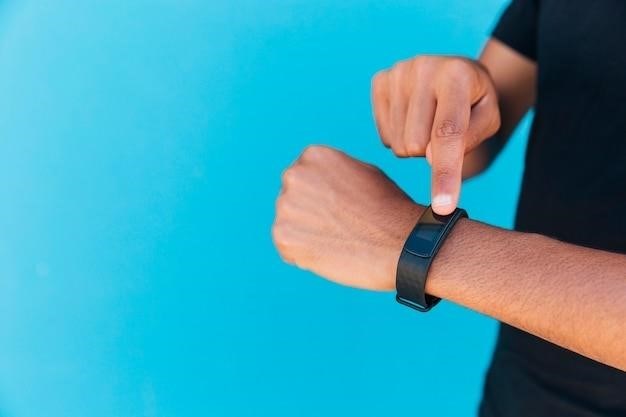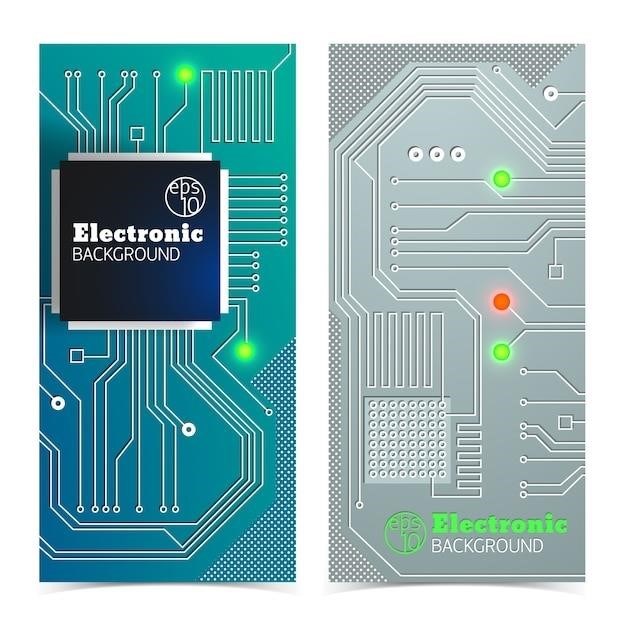Smartwatch User Manual⁚ A Comprehensive Guide
This comprehensive guide provides essential instructions for setting up, using, and troubleshooting your smartwatch․ Learn about pairing with your smartphone, navigating the interface, utilizing key apps, and optimizing battery life․ Discover health and fitness tracking features, manage notifications, and explore advanced customization options․ Safety precautions and solutions for common issues are also included․
Getting Started⁚ Initial Setup and Charging
Before using your new smartwatch, ensure it’s fully charged․ Most smartwatches require a proprietary charging cable; check your packaging for specifics․ Connect the cable to the watch and a power source․ A charging indicator (light or screen display) will confirm charging․ Charging times vary, typically ranging from one to two hours for a full charge․ Some models may offer wireless charging․ Refer to your specific smartwatch’s manual for detailed charging instructions․ Once charged, power on your watch using the designated button (often a side button requiring a long press)․ The initial setup may involve connecting to your smartphone via Bluetooth․ The process varies by model, but usually involves downloading a companion app (often mentioned in the quick-start guide), enabling Bluetooth on your phone, and following the on-screen instructions on both your phone and smartwatch to establish the connection․ You might need to create an account and allow necessary permissions for the app to function correctly․ After successful pairing, you can start exploring the watch’s features and functionalities․
Pairing Your Smartwatch with Your Smartphone
Pairing your smartwatch with your smartphone is crucial for accessing many features․ First, ensure Bluetooth is enabled on your phone․ Next, download and install the companion app from your phone’s app store (the app’s name is usually specified in your smartwatch’s documentation)․ Open the app and follow the on-screen instructions; you’ll likely need to create an account․ On your smartwatch, navigate to the Bluetooth settings (the exact method varies by model; consult your manual)․ Put your smartwatch into pairing mode (often indicated by a flashing Bluetooth symbol); this usually involves holding down a button for a few seconds․ The app will then search for available devices; select your smartwatch from the list․ You may be prompted to confirm a pairing code on both your phone and watch․ Once paired, the app will often allow you to customize notifications, access fitness data, and manage other smartwatch settings․ If you encounter problems, check that Bluetooth is enabled on both devices, and that your smartwatch is within range (typically 10 meters or less)․ Restarting both your phone and smartwatch can sometimes resolve connectivity issues․ Refer to your smartwatch’s user manual for model-specific troubleshooting steps․
Navigating the User Interface⁚ Key Features and Functions
Your smartwatch’s user interface (UI) will vary depending on the model, but common elements include a touchscreen and physical buttons․ The touchscreen allows for swiping through menus and selecting options․ Typical gestures include swiping up or down to scroll through lists, left or right to navigate between screens, and tapping to select items; Physical buttons often serve as shortcuts for functions like returning to the home screen, activating the voice assistant, or accessing quick settings․ The home screen usually displays the time, date, and potentially other essential information like steps taken or heart rate․ From the home screen, you can typically access various apps and settings․ Many smartwatches use a combination of icons and text to represent different functions․ To find specific features, use the search function within the settings menu or consult the user manual for your particular smartwatch model․ Understanding the navigation gestures and button functions is essential for efficient use․ Familiarize yourself with the UI by experimenting with the different controls․ The learning curve is generally short, and the intuitive design makes navigation straightforward․ The user manual for your specific smartwatch model should provide detailed instructions on navigating its specific UI․
Essential Apps and Their Functionality

Your smartwatch likely comes pre-loaded with several essential apps, and more can be added depending on your operating system and device compatibility․ A core application is usually a fitness tracker, monitoring steps, heart rate, sleep patterns, and potentially other metrics․ Many smartwatches also include a notification center, mirroring alerts from your paired smartphone․ This allows you to quickly check messages, calls, and calendar events without reaching for your phone․ A music player app lets you control music playback from your phone or even store music directly on the watch for offline listening․ Some models offer built-in GPS for tracking outdoor workouts․ Weather apps provide real-time weather updates for your current location․ A timer and stopwatch are convenient for tracking time during activities․ Other apps may include a calculator, world clock, or even mobile payment functionality, depending on the smartwatch’s capabilities and your region․ Remember that app availability and functionality can vary significantly between different smartwatch models and operating systems․ Consult your smartwatch’s user manual or the app store for detailed information on available apps and their features․
Health and Fitness Tracking⁚ Monitoring Your Activity
Many smartwatches offer robust health and fitness tracking capabilities․ Most will track your daily steps, distance traveled, and calories burned, providing a comprehensive overview of your physical activity levels․ Heart rate monitoring is a standard feature on many devices, allowing you to track your resting heart rate and heart rate variability throughout the day and during workouts․ Some smartwatches also include advanced features such as blood oxygen saturation (SpO2) monitoring, sleep tracking (analyzing sleep stages and duration), and stress level detection․ The accuracy of these health metrics varies depending on the sensor technology used and the individual’s physiology․ For more detailed workout data, many smartwatches can connect to GPS for accurate distance and pace tracking during outdoor activities like running or cycling․ Some advanced models might even provide advanced metrics such as VO2 max estimations or recovery time suggestions․ Remember to calibrate your smartwatch accurately and ensure a proper fit for optimal data collection․ The data collected can be viewed on the smartwatch itself or synced with a companion smartphone app for more detailed analysis and long-term trend tracking․ Use this information to stay informed and motivated to achieve your fitness goals․
Notifications and Communication⁚ Staying Connected
Stay connected on the go with your smartwatch’s notification features․ Once paired with your smartphone, your smartwatch will mirror many of your phone’s notifications, including calls, text messages, emails, and app alerts․ You can customize notification settings to prioritize important alerts and filter out less critical ones․ Many smartwatches allow you to reply directly to text messages or view message previews, eliminating the need to constantly check your phone․ Some advanced models even support voice-to-text functionality for quick replies․ The convenience of receiving notifications directly on your wrist keeps you informed without needing to constantly reach for your phone․ Remember that the specific notification features available will vary depending on your smartwatch model and the connected smartphone operating system (iOS or Android)․ Beyond notifications, some smartwatches offer basic communication features․ You might be able to make and receive calls directly from your watch, especially if it has cellular connectivity․ However, the quality of these calls can be affected by the network’s signal strength․ Always consult your smartwatch’s user manual for specific instructions on managing notifications and communication settings․
Troubleshooting Common Issues and Solutions
Encountering problems with your smartwatch? This section offers solutions for common issues․ If your smartwatch isn’t connecting to your smartphone, ensure Bluetooth is enabled on both devices and that they are within range․ Try restarting both devices, and if necessary, delete and re-pair them․ A slow or unresponsive touchscreen might require a software update․ Check for available updates through the associated smartphone app․ If the battery drains quickly, adjust settings such as screen brightness and notification frequency to conserve power․ For charging issues, inspect the charging cable and port for any damage or obstructions․ If the charging indicator doesn’t light up, try a different cable or charging port․ Remember to consult your smartwatch’s user manual for specific troubleshooting instructions․ If your smartwatch isn’t tracking your fitness data accurately, ensure the sensors are clean and making proper contact with your skin․ Calibration might be necessary for certain sensors; refer to your manual for details․ If none of these steps resolve the problem, contact customer support for assistance․ They might be able to offer more specific solutions based on your smartwatch’s model and the nature of the issue․ Keeping your software updated can also prevent and resolve many issues, so remember to check for updates regularly․ Remember to always consult your warranty before undertaking any advanced troubleshooting steps․
Battery Life and Charging Instructions
Optimizing your smartwatch’s battery life involves understanding its usage patterns and adjusting settings accordingly․ Factors affecting battery life include screen brightness, the frequency of notifications, the use of GPS and heart-rate monitoring, and the number of active apps․ Reducing screen brightness, limiting background app activity, and turning off features like always-on display can significantly extend battery life․ Regularly checking for and installing software updates can also improve battery performance․ To charge your smartwatch, connect it to the provided charging cable and adapter․ Ensure the charging port is clean and free from debris․ The charging time varies depending on the smartwatch model and its current battery level; typically, a full charge takes one to two hours․ Avoid using unofficial chargers, as these might damage your smartwatch’s battery or circuitry․ During the initial charge, you might observe a longer charging time than subsequent charges․ While charging, you might see a charging screen or indicator light on your smartwatch, confirming that it is properly charging․ Always refer to your smartwatch’s user manual for specific instructions and safety precautions related to battery charging․ Proper charging practices will prolong the lifespan of your device and maintain optimal performance․ Never leave your smartwatch charging unattended for extended periods․
Safety Precautions and Important Information

Prioritize safety when using your smartwatch․ Avoid wearing it during strenuous activities that could cause damage or injury․ Remove the smartwatch before showering, swimming, or engaging in activities involving excessive moisture or water immersion, unless specifically designed for such uses․ Keep the device and its accessories away from extreme temperatures, direct sunlight, and open flames․ Do not attempt to disassemble or repair the smartwatch yourself, as this could void the warranty and potentially cause damage․ Use only the manufacturer-approved charging cable and adapter to prevent battery damage or electrical hazards․ If the smartwatch malfunctions or shows signs of overheating, discontinue use immediately and contact customer support for assistance․ Be mindful of the information you share through your smartwatch, especially when connected to the internet․ Ensure that your device’s software is updated regularly to benefit from the latest security patches and performance enhancements․ Handle the device with care to avoid dropping or damaging it․ The information provided in this manual is for guidance only; always consult your specific smartwatch’s instructions for detailed usage information and safety precautions․ This smartwatch is a general wellness product and should not be used as a medical device for diagnosis or treatment of any health conditions․ Consult a healthcare professional for any health-related concerns․
Advanced Features and Customization Options
Unlock the full potential of your smartwatch by exploring its advanced features and customization options․ Many smartwatches offer customizable watch faces, allowing you to personalize the display with various styles, colors, and information widgets․ You can select preferred data points to be prominently featured, such as the time, date, steps taken, heart rate, or notifications․ Some models support the addition of new apps and widgets extending functionality beyond the pre-installed options․ Explore the app store or settings menu to discover available additions, such as specialized fitness apps, music players, or weather widgets․ Adjust notification settings to control which apps can send alerts to your watch․ Configure the vibration intensity and notification style to your preferences․ Many smartwatches allow you to customize the display brightness, screen timeout duration, and other visual settings for optimal readability in different lighting conditions․ Dive into the settings menu to discover features such as Do Not Disturb mode, which silences notifications during specified times․ Explore options for setting alarms, timers, and stopwatches directly on your smartwatch, independent of your smartphone․ Some models offer advanced features like GPS tracking for detailed workout analysis, contactless payments, or even offline music playback․ Remember to consult your smartwatch’s specific user manual for a comprehensive guide to its advanced features and customization options;





